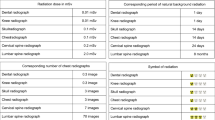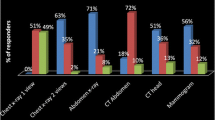Abstract
Background
There is increasing awareness among pediatric radiologists of the potential risks associated with ionizing radiation in medical imaging. However, it is not known whether there has been a corresponding increase in awareness among pediatricians.
Objective
To establish the level of awareness among pediatricians of the recent publicity on radiation risks in children, knowledge of the relative doses of radiological investigations, current practice regarding parent/patient discussions, and the sources of educational input.
Materials and methods
Multiple-choice survey.
Results
Of 220 respondents, 105 (48%) were aware of the 2001 American Journal of Roentgenology articles on pediatric CT and radiation, though only 6% were correct in their estimate of the quoted lifetime excess cancer risk associated with radiation doses equivalent to pediatric CT. A sustained or transient increase in parent questioning regarding radiation doses had been noticed by 31%. When estimating the effective doses of various pediatric radiological investigations in chest radiograph (CXR) equivalents, 87% of all responses (and 94% of CT estimates) were underestimates. Only 15% of respondents were familiar with the ALARA principle. Only 14% of pediatricians recalled any relevant formal teaching during their specialty training. The survey response rate was 40%.
Conclusion
Awareness of radiation protection issues among pediatricians is generally low, with widespread underestimation of relative doses and risks.




Similar content being viewed by others
References
Donnelly LF (2002) Lessons from history. Pediatr Radiol 32:287–292
Doll R, Wakeford R (1997) Risk of childhood cancer from fetal irradiation. Br J Radiol 70:130–139
Levy AR, Goldberg MS, Hanley JA, et al (1994) Projecting the lifetime risk of cancer from exposure to diagnostic ionizing radiation for adolescent idiopathic scoliosis. Health Phys 66:621–633
Modan B, Keinan L, Blumstein T, et al (2000) Cancer following cardiac catheterization in childhood. Int J Epidemiol 29:424–428
Doody M, Michele MS, Lonstein JE, et al (2000) Breast cancer mortality after diagnostic radiography: findings from the US Scoliosis Cohort Study. Spine 25:2052–2063
Infante-Rivard C, Mathonnet G, Sinnett D (2000) Risk of childhood leukemia associated with diagnostic irradiation and polymorphisms in DNA repair genes. Environ Health Perspect 108:495–498
Shu X-O, Jin F, Linet MS, et al (1994) Diagnostic X-ray and ultrasound exposure and risk of childhood cancer. Br J Cancer 70:531–536
Pierce DA, Shimizu Y, Preston DL, et al (1996) Studies of the mortality of atomic bomb survivors. Report 12, part 1. Cancer: 1950–1990. Radiat Res 146:1–27
ICRP (1991) 1990 Recommendations of the International Commission on Radiological Protection. ICRP publication no. 60. Pergamon, Oxford
Brenner DJ, Elliston CD, Hall EJ, et al (2001) Estimated risks of radiation-induced fatal cancer from pediatric CT. AJR 176:289–296
Pierce DA, Preston DL (2000) Radiation-related cancer risks at low doses among atomic bomb survivors. Radiat Res 154:178–186
Paterson A, Frush DP, Donnelly LF (2001) Helical CT of the body: are settings adjusted for pediatric patients? AJR 176:297–301
Donnelly LF, Emery KH, Brody AS, et al (2001) Minimizing radiation dose for pediatric body applications of single-detector helical CT: strategies at a large children’s hospital. AJR 176:303–306
Sternberg S (2001) CT scans in children linked to cancer later. USA Today, January 22
Donnelly LF, Frush DP (2001) Fallout from recent articles on radiation dose and pediatric CT. Pediatr Radiol 31:338
Quinn AD, Taylor CG, Sabharwal T, et al (1997) Radiation protection awareness in non-radiologists. Br J Radiol 70:102–106
Shiralkar S, Rennie A, Snow M, et al (2003) Doctor’s knowledge of radiation exposure: questionnaire study. BMJ 327:371–372
Lee CL, Haims AH, Monico EP, et al (2004) Diagnostic CT scans: assessment of patient, physician and radiologist awareness of radiation dose and possible risks. Radiology 231:393–398
Brenner DJ (2002) Estimating cancer risks from pediatric CT: going from the qualitative to the quantitative. Pediatr Radiol 32:228–231
Huda W (2002) Effective doses to adult and pediatric patients. Pediatr Radiol 32:272–279
McCollough CH, Schueler B (2000) Educational treatise – calculation of effective dose. Med Phys 27:828–837
Huda W, Gkanatsios NA (1997) Effective dose and energy imparted in diagnostic radiology. Med Phys 24:1311–1316
Thomas KE, Haidar S, Parnell-Parmley JE, et al (2006) Calculation of effective doses for pediatric radiological investigations. Manuscript under preparation
National Radiological Protection Board (1990) Patient dose reduction in diagnostic radiology. Documents of the NRPB, vol. 1, no. 3
Huda W, Slone R (2003) Review of radiologic physics (2nd edn). Lippincott Williams and Wilkins, Philadelphia
Nickoloff E (2002) Current adult and pediatric CT doses. Pediatr Radiol 32:250–260
McCollough CH, Zink FE (1999) Performance evaluation of a multi-slice CT system. Med Phys 26:2223–2230
Greess H, Nomayr A, Wolf H, et al (2002) Dose reduction in CT examination of children by an attenuation-based on-line modulation of tube current (CARE dose). Eur Radiol 12:1571–1576
RSNA News (2003) Government may label radiation as carcinogen. RSNA news, March 2003
Report on Carcinogens, Eleventh Edition; U.S. Department of Health and Human Services, Public Health Service, National Toxicology Program. http://ntp-server.niehs.nih.gov/ntp/roc/toc11.html
Mettler FA Jr, Wiest PW, Locken JA, et al (2000) CT scanning: patterns of use and dose. J Radiol Prot 20:353–359
Society of Pediatric Radiology (2002) The ALARA concept in pediatric CT intelligent dose reduction. Multidisciplinary conference, 18–19 August 2001. Panel discussion. Pediatr Radiol 32:242–244
Donnelly LF, Frush DP (2001) Fallout from recent articles on radiation dose and pediatric CT. Pediatr Radiol 31:338
FDA (2001) Public Health Notification. Reducing radiation risk from computed tomography for pediatric and small adult patients
Slovis TL (ed) (2002) The ALARA concept in pediatric CT intelligent dose reduction. Multidisciplinary conference, 18–19 August 2001. Pediatr Radiol 32:217–313
Hollingsworth C, Frush DP, Cross M, et al (2003) Helical CT of the body: a survey of techniques used for pediatric patients. AJR 180:401–406
Khursheed A, Hillier MC, Shrimpton PC, et al (2002) Influence of patient age on normalized effective doses calculated for CT examinations. Br J Radiol 75:819–830
Huda W, Atherton JV, Ware DE, et al (1997) An approach for the estimation of effective radiation dose at CT in pediatric patients. Radiology 203:417–422
Shrimpton PC, Hillier MC, Lewis MA, et al (2005) Doses from computed tomography examinations in the UK–2003 review. NRPB-W67, NRPB Publications. http://www.hpa.org.uk/radiation/publications/index.htm
Picano E (2004) Sustainability of medical imaging. BMJ 328:578–580
FDA (2005) What are the radiation risks from CT? http://www.fda.gov/cdrh/ct/risks.html
De Campo JF, Lau KKP, De Campo MP (2003) Is informed consent necessary for paediatric computed tomography? J Paediatr Child Health 39:399–400
Frush D (2003) Responsible use of CT. Radiology 229:289–291
Frush DP, Donnelly LF, Rosen NS (2004) Computed tomography and radiation risks: what pediatric health providers should know. Pediatrics 112:951–957
Acknowledgement
We thank the technical staff of the Department of Diagnostic Imaging at the Hospital for Sick Children for their help and support of this project.
Author information
Authors and Affiliations
Corresponding author
Rights and permissions
About this article
Cite this article
Thomas, K.E., Parnell-Parmley, J.E., Haidar, S. et al. Assessment of radiation dose awareness among pediatricians. Pediatr Radiol 36, 823–832 (2006). https://doi.org/10.1007/s00247-006-0170-x
Received:
Revised:
Accepted:
Published:
Issue Date:
DOI: https://doi.org/10.1007/s00247-006-0170-x




